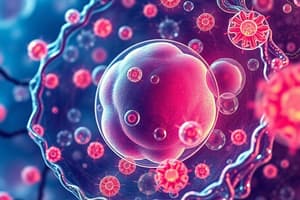Podcast
Questions and Answers
What is the role of the cytoplasm in the cell?
What is the role of the cytoplasm in the cell?
- To provide structural support to the cell
- To control the movement of materials in and out of the cell
- To synthesize proteins and lipids (correct)
- To house the cell's genetic material
What is the composition of the cell membrane?
What is the composition of the cell membrane?
- A single layer of proteins
- A layer of DNA molecules
- A phospholipid bilayer (correct)
- A mixture of carbohydrates and lipids
What is the primary function of the cell membrane?
What is the primary function of the cell membrane?
- To synthesize proteins and lipids
- To house the cell's genetic material
- To provide structural support to the cell
- To control the movement of materials in and out of the cell (correct)
What is the purpose of cellular junctions?
What is the purpose of cellular junctions?
What is the function of the nucleus in a cell?
What is the function of the nucleus in a cell?
Which organelle is responsible for modifying, sorting, and packaging proteins and lipids for transport?
Which organelle is responsible for modifying, sorting, and packaging proteins and lipids for transport?
What is the largest organelle in a eukaryotic cell?
What is the largest organelle in a eukaryotic cell?
What is the primary function of the mitochondria in a cell?
What is the primary function of the mitochondria in a cell?
Which organelle is responsible for photosynthesis in plant cells?
Which organelle is responsible for photosynthesis in plant cells?
What is the role of the nucleolus in a cell?
What is the role of the nucleolus in a cell?
Which organelle is responsible for breaking down waste materials within the cell?
Which organelle is responsible for breaking down waste materials within the cell?
What is the primary function of the nucleus in a cell?
What is the primary function of the nucleus in a cell?
Flashcards are hidden until you start studying
Study Notes
Cell Structure
A cell is the basic unit of life, and understanding its structure is crucial for understanding the functioning of all living organisms. This article provides a comprehensive overview of the cell structure, focusing on the subtopics of cell membrane, cytoplasm, cellular junctions, nucleus, and organelles.
Cell Membrane
The cell membrane, also known as the plasma membrane, is a vital component of a cell. It separates the interior of the cell from the external environment and controls the movement of materials in and out of the cell. The cell membrane is composed of a phospholipid bilayer, with the hydrophilic (water-soluble) heads facing outwards and the hydrophobic (water-insoluble) tails facing inwards.
Cytoplasm
The cytoplasm is the jelly-like substance found inside the cell membrane. It is a gel-like mixture of water, proteins, and various other molecules. The cytoplasm plays a crucial role in the cell's metabolic processes, including the synthesis of proteins, lipids, and nucleic acids.
Cellular Junctions
Cellular junctions are specialized structures that connect cells to each other, allowing for communication and coordination between cells. There are three main types of cellular junctions: tight junctions, gap junctions, and desmosomes.
Nucleus
The nucleus is the control center of the cell, housing the cell's genetic material, or DNA. It is the largest organelle within a eukaryotic cell and is enclosed by a double membrane. The nucleus is responsible for directing the cell's activities by controlling the expression of genes and coordinating cellular processes.
Organelles
Organelles are specialized structures within a cell that perform specific functions. Some of the most important organelles include:
- Mitochondria: These organelles are responsible for producing energy in the form of ATP through a process called aerobic respiration.
- Endoplasmic Reticulum (ER): The ER is a network of flattened sacs that play a role in protein synthesis and lipid metabolism.
- Golgi Apparatus: The Golgi apparatus modifies, sorts, and packages proteins and lipids for transport to their final destinations within the cell or for export.
- Nucleolus: The nucleolus is a small, dense structure within the nucleus that synthesizes ribosomes, which are essential for protein synthesis.
- Chloroplasts: Chloroplasts, found in plant cells, are responsible for photosynthesis, the process by which plants convert light energy into chemical energy.
- Lysosomes: Lysosomes are membrane-bound organelles that contain digestive enzymes and play a role in breaking down waste materials within the cell.
- Peroxisomes: Peroxisomes are small organelles involved in the catabolism of fatty acids and the detoxification of harmful substances.
In summary, the cell structure is a complex and intricate system that allows cells to perform their essential functions. Understanding the various components of cell structure, including the cell membrane, cytoplasm, cellular junctions, nucleus, and organelles, is crucial for understanding the functioning of all living organisms.
Studying That Suits You
Use AI to generate personalized quizzes and flashcards to suit your learning preferences.




